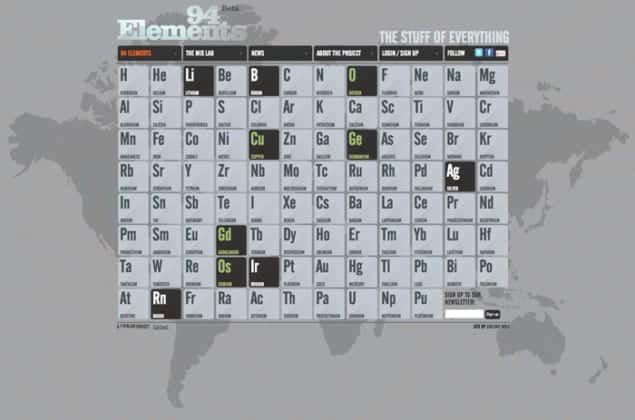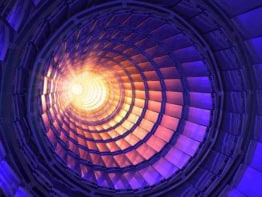URL: www.94elements.com

So what is the site about?
94 Elements is a documentary film project about how people interact with the chemical elements. In its format (short films) and its structure (one film about each element), the site owes an obvious debt to the University of Nottingham’s excellent Periodic Table of Videos site, which was the subject of the very first Web life column (January 2009 p35). However, the resemblance between the two sites ends there. While the videos that make up Nottingham’s periodic table concentrate on the elements’ chemical properties and applications, the films in 94 Elements have a much more human and environmental slant. The film “Copper: acid and dust”, for example, shows a group of men from Bihar, one of India’s poorest states, extracting copper from old printed circuit boards by steeping them in barrels of nitric acid. Their work is dangerous and illegal, made possible by bribes to Indian officials and (the film implies) by a “throwaway” culture that nevertheless places more value on things than it does on human beings.
Which other elements are covered?
Copper is one of only five elements to receive the cinematic treatment so far (the others are oxygen, germanium, gadolinium and osmium) but another five films are currently in the works and the project’s leader, Mike Paterson, hopes that the site will eventually contain films about all the elements from hydrogen to plutonium (element 94) on the periodic table. Paterson has made the films on copper and germanium himself, while the other three are by different directors from the UK, Georgia and the Netherlands.
What are some highlights?
Nino Kirtadze’s film “Gadolinium: scan” takes as its subject the use of gadolinium in MRI scans to improve contrast between normal and abnormal tissue. In the seven-minute film, the central figure, a Georgian man called Levan, has a scan on his shoulder, then spends the rest of the film puzzling over medical jargon and arguing with his friends and extended family about what the results mean. Some of their conversations are funny as well as poignant, as when a few of Levan’s relatives seem to revel in the possibly gruesome consequences of his injury. “There can be pus, then maybe gangrene, and then they’ll cut your arm off,” says one with apparent satisfaction. “And it’s so close to your head!” another adds helpfully as Levan squints at the gadolinium-enhanced images.
Why only 94 elements?
Good question. In a project about our use of natural resources, it probably makes sense to exclude the exotic elements high up in the periodic table; even the all-encompassing Periodic Table of Videos does not have much to say about ununoctium. But Paterson’s rationale for selecting these particular 94 elements seems flawed. The site claims that “there are 94 naturally occurring elements, from hydrogen to plutonium”, but its definition of “naturally occurring” must be either too broad or too narrow, since it includes several elements, including plutonium itself, that exist naturally only in trace quantities, while excluding others. This is a pity, because a few of the heavier elements could make interesting films. For example, the 95th element, americium, is used in some types of smoke detector.
Why should I visit?
Paterson has a good track record of making films about science and people. His previous project, Colliding Particles, was a series of 12 films about CERN researchers and the search for the Higgs boson (November 2009 p39), and it will be interesting to see how this new work develops over time. Several of the upcoming films look promising, including one about the impending shortage of indium (a key ingredient in the manufacture of solar cells and other electronics) and the intriguingly-titled “Boron: mon amour”, which is being filmed (where else?) in Boron, California. Paterson is also developing new features for the site, including the Mix Lab, which hosts films about chemical compounds rather than elements, and “a range of interactive tools and visualizations exploring our use and exploitation of the elements”. In the future, Paterson says, there will be opportunities for people to pitch their own film ideas, and to vote on which films should get priority for whatever funding becomes available. Just don’t mention americium.



